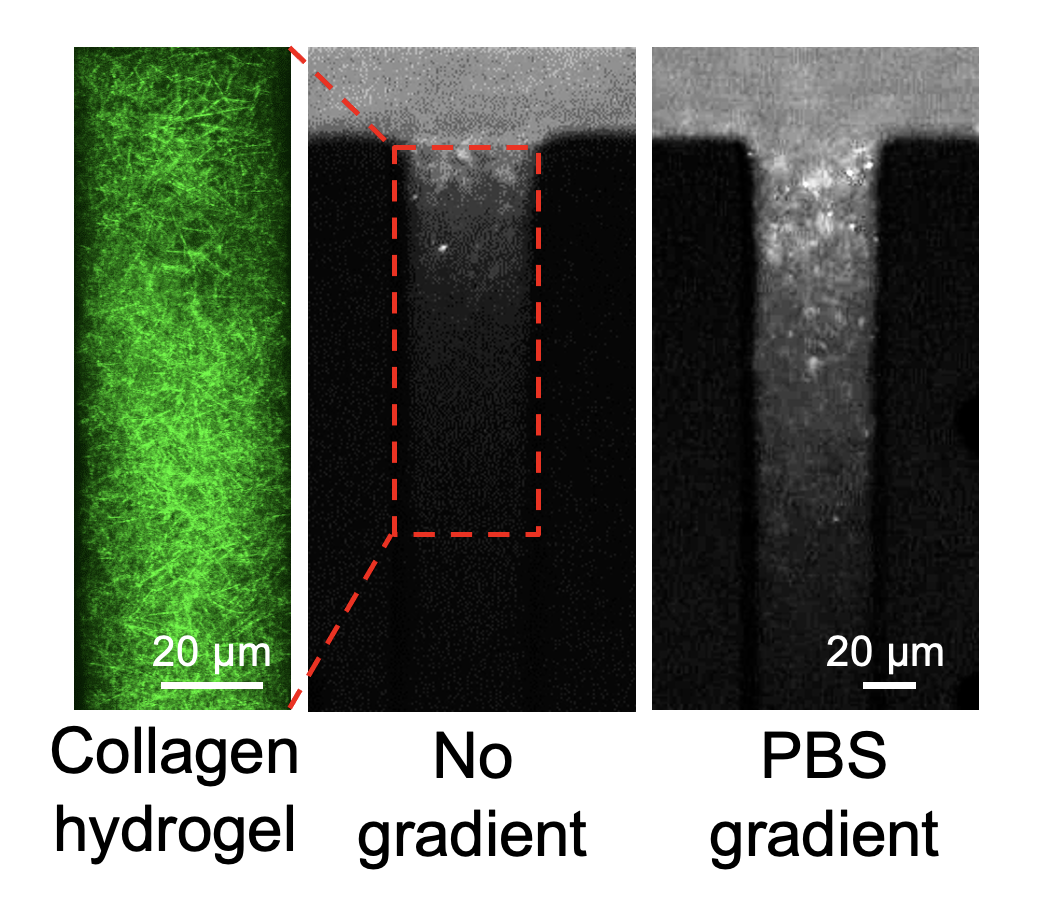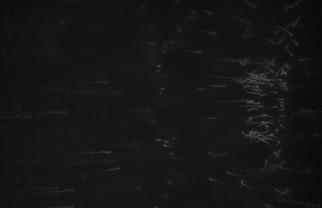The central focus of our research revolves around transport phenomena of complex fluids at small scales. Complex fluids, also known as soft matter, are unique substances having multiple co-existing phases such as colloids (solid in liquid), gels (liquid in solid), emulsion (liquid in liquid), and foams (gas in liquid). Such diverse blends of substances have a profound impact on our daily lives – from plastics, oil production, personal care, and culinary art to cancer treatment and disease transmission, to name a few. Our group is particularly interested in the dynamical behaviors of complex fluids, such as how they move, react, or transform in response to external stimuli. Below we showcase some of the recent research activities led by our group. We are always seeking exciting collaboration opportunities so feel free to reach out!
|
Shape- and orientation-dependent diffusiophoresis of colloidal ellipsoids
Contrary to the common expectation that diffusiophoresis is shape independent, we have shown experimentally that this assumption breaks down when the thin Debye layer approximation is relaxed. By tracking the translation and rotation of various ellipsoids, we found that the phoretic mobility of ellipsoids is sensitive to the eccentricity and the orientation of the ellipsoid relative to the imposed solute gradient, and can further lead to nonmonotonic behavior under strong confinement. We have also shown that such a shape- and orientation-dependent diffusiophoresis of colloidal ellipsoids can be easily captured by modifying theories for spheres. Doan et al., Phys. Rev. E 107 L052602 (2023) |
|
Confinement-dependent diffusiophoresis of nanoparticles in collagen hydrogels
The transport of nanoparticles in biological hydrogels is often hindered by the strong confinement of the media, thus limiting important applications such as drug delivery and disinfection. Here, we investigate nanoparticle transport in collagen hydrogels driven by diffusiophoresis. Contrary to common expectations for boundary confinement effects where the confinement hinders diffusiophoresis, we observe a non-monotonic behavior in which maximum diffusiophoretic mobility is observed at intermediate confinement. We find that such behavior is a consequence of the interplay between multiple size-dependent effects. Our results display the utility of diffusiophoresis for enhanced nanoparticle transport in physiologically relevant conditions under tight confinement, suggesting a potential strategy for drug delivery in compressed tissues. Doan et al., Nano Lett. 21 7625 (2021) |
|
Salinity-mediated oil recovery in porous media
High and low salinity water flooding are common oil recovery processes performed in the oil fields for extracting crude oil from the reservoir. These processes are often performed sequentially, naturally establishing non-uniform salinity in the porous subsurface. In this article, we investigate oil transport in porous media induced by salinity change upon flooding with high and low salinity water. As we observe a large number of impervious dead-ends from three-dimensional imaging of the actual reservoir, we identify that these areas play an important role in oil recovery where the oil transport is governed by the salinity change rather than hydrodynamics. The salinity gradients induced upon high salinity water flooding provide pathways to enhance the transport of oil drops trapped in the dead-end regions via non-equilibrium effects. However, above a critical salinity, we observe a rapid aggregation of drops that lead to the complete blockage of the pore space, thereby inhibiting oil recovery. We also find that, at an intermediate salinity where the drop aggregation is modest, the aggregation rather promotes the oil recovery. Our observations suggest that there exist optimal salinity conditions for maximizing oil recovery during chemical flooding. Park et al., Energy & Fuels 35 4885 (2021) |
|
Colloidal banding via pH-dependent electrokinetics
Electroosmosis on non-uniformly charged surfaces often gives rise to intriguing flow behaviors, which can be utilized in applications such as mixing processes and designing micromotors. Here, we demonstrate non-uniform electroosmosis induced by electrochemical reactions. Water electrolysis creates pH gradients near the electrodes that cause a spatiotemporal change in the wall zeta potential, leading to non-uniform electroosmosis. Such non-uniform electroosmotic flows induce multiple vortices, which promote the continuous accumulation of particles that subsequently form a colloidal band. The band develops vertically into a “wall” of particles that spans from the bottom to the top surface of the chamber. Such a flow-driven colloidal band can be potentially used in colloidal self-assembly and separation processes irrespective of the particle surface properties. For instance, we demonstrate these vortices can promote rapid segregation of soft colloids such as oil droplets and fat globules. Doan et al., Electrophoresis 42 2356 (2021) |
|
Diffusiophoretic swimming of bacteria triggered by surfactants
From birth to health, surfactants play an essential role in our lives. Due to the importance, their environmental impacts are well understood. One of the aspects that has been extensively studied is their impact on bacteria, particularly on their motility. Here, we uncover an alternate chemotactic strategy triggered by surfactants – diffusiophoresis. We show that even a trace amount of ionic surfactants, down to a single ppm level, can promote the bacterial diffusiophoresis by boosting the surface charge of the cells. Because diffusiophoresis is driven by the surface−solute interactions, surfactant-enhanced diffusiophoresis is observed regardless of the types of bacteria. Whether Gram-positive or -negative, flagellated or non-flagellated, the surfactants enable fast migration of freely suspended bacteria, suggesting a ubiquitous locomotion mechanism that has been largely overlooked. We also demonstrate the implication of surfactant-enhanced bacterial diffusiophoresis on the rapid formation of biofilms in flow networks, suggesting environmental and biomedical implications. Doan et al., ACS Nano 14 14219 (2020) |
|
Osmotic delivery and release of lipid vesicles
Passive targeted drug delivery to solid tumors is driven by the permeation of drug carriers through porous vasculature. Due to a dominant transport mechanism for the entry and migration of the drug carriers being diffusion, the passive drug delivery is relatively slow and ineffective in delivering large carriers to the desired location. Here, we propose a method for delivering liposomes into the interstitium at orders of magnitude faster than the diffusion. Using microfluidic model tumor microenvironment, we show that by exchanging the solutes of the interstitial fluid, the liposomes can respond to the change in the chemistry of the surrounding fluid, thereby penetrating deep into the confined pore space at an accelerated transport rate. In addition, by further exchanging the environment with a hypotonic solution, the delivered liposomes can expel their inner content continuously via periodic osmotic bursting, allowing controlled release of encapsulated molecules in hard-to-reach spaces. Our study suggests an active delivery strategy to enhance the permeation of therapeutic molecules into the interstitium. Shin et al., Phys. Rev. Appl. 12 024014 (2019); Kumar et al., Soft Matter 16 8904 (2020) |
|
Membraneless particle separation by dissolution of CO2
Water purification technologies such as microfiltration/ultrafiltration and reverse osmosis utilize porous membranes to remove suspended particles and solutes. These membranes, however, cause many drawbacks such as a high pumping cost and a need for periodic replacement due to fouling. Here we present an alternative membraneless method for separating suspended particles by exposing the colloidal suspension to CO2. Dissolution of CO2 into the suspension creates solute gradients that drive phoretic motion of particles. Due to the large diffusion potential generated by the dissociation of carbonic acid, colloidal particles move either away from or towards the gas-liquid interface depending on their surface charge. Using the directed motion of particles induced by exposure to CO2, we demonstrate a scalable, continuous flow, membraneless particle filtration process that exhibits low energy consumption, three orders of magnitude lower than conventional microfiltration/ultrafiltration processes, and is essentially free from fouling. Shin et al., Nat. Commun., 8 15181 (2017); Shimokusu et al., Langmuir, 36 7032 (2020) |
|
Enhanced boiling heat transfer using smart nanomaterials
We present a new concept of a structured surface for enhanced boiling heat transfer that is capable of self-adapting to the local thermal conditions. An array of freestanding nanoscale bimorphs, a structure that consists of two adjoining materials with a large thermal expansion mismatch, is able to deform under local temperature change. Such a surface gradually deforms as the nucleate boiling progresses due to the increase in the wall superheat. The deformation caused by the heated surface is shown to be favorable for boiling heat transfer, leading to about 10% of increase in the critical heat flux compared to a regular nanowire surface. A recently developed theoretical model that accounts for the critical instability wavelength of the vapor film and the capillary wicking force successfully describes the critical heat flux enhancement for the nanobimorph surface with a good quantitative agreement. Shin et al., Nano Lett. 18 6392 (2018) |
|
De-mixing by mixing: Particle trapping in flow junctions via fluid-solute-colloid-boundary interactions
The flow of solutions containing solutes and colloidal particles in porous media is widely found in systems including underground aquifers, hydraulic fractures, estuarine or coastal habitats, water filtration systems, etc. In such systems, solute gradients occur when there is a local change in the solute concentration. While the effects of solute gradients have been found to be important for many applications, we observe an unexpected colloidal behavior in porous media driven by the combination of solute gradients and the fluid flow. When two flows with different solute concentrations are in contact near a junction, a sharp solute gradient is formed at the interface, which may allow strong diffusiophoresis of the particles directed against the flow. Consequently, the particles accumulate near the pore entrance, rapidly approaching the packing limit. These colloidal dynamics have important implications for the clogging of a porous medium, where particles that are orders of magnitude smaller than the pore width can accumulate and block the pores within a short period of time. We also show that this effect can be exploited as a useful tool for preconcentrating biomolecules for rapid bioassays. Shin et al., Phys. Rev. X, 7 041038 (2017); Shin et al. Phys. Rev. Fluids 5 024304 (2020) |
|
Cleaning by surfactant gradients: Significance of rinsing in laundry detergency
Removing particles from fibrous materials involves loosening via surfactants followed by particle transfer in a flow. While flow advection is commonly believed to be the major driver for pore-scale transport, small pores within the fabric do not allow any significant fluid flow inside them, thus significantly reducing the role of advection. However, rinsing the fabric with fresh water naturally establishes a surfactant gradient within the pore space, providing a suitable environment for particles to undergo diffusiophoresis. We demonstrate that this mechanism can remove particles from deep within fabric pores at an accelerated rate. The nonlinear aspect of diffusiophoresis significantly prolongs the lifetime of the phoretic motion beyond the naive solute diffusion time scale during rinsing, allowing long-lasting, continuous removal of particles. Moreover, owing to the fine balance between chemiphoresis and electrophoresis for particles in anionic surfactant concentration gradients, we show that the particle removal is sensitive to the counterion mobility, suggesting a simple route to control the effect. We thus claim to have resolved the “stagnant core problem”—a long-standing mystery in laundry detergency—and have identified a physicochemical approach to particle transport in fibrous media with broad applicability. Shin et al., Phys. Rev. Appl, 9 034012 (2018); Warren et al., Soft Matter, 15 278 (2019) |









